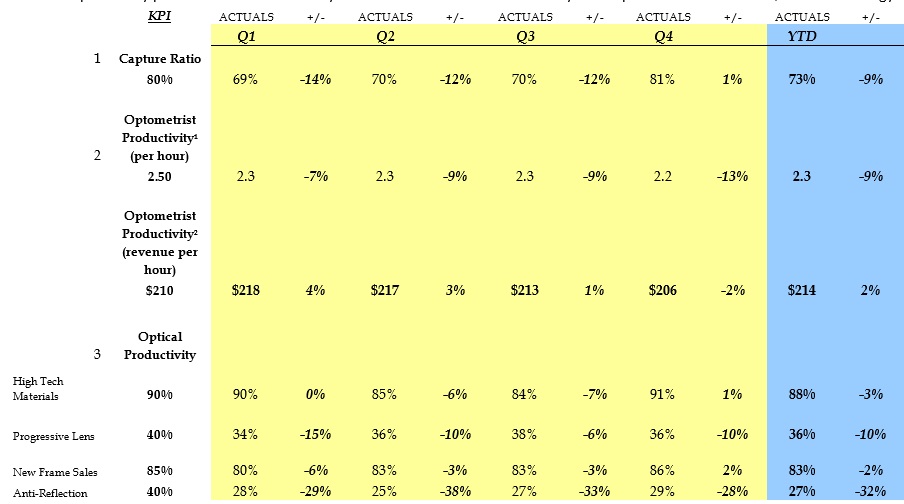By Steve Sunder

June 6, 2018
Key performance indicators (KPIs) give you a way to easily gauge staff performance. Here’s how to establish KPIs, and use them to better serve patients, and become more profitable.
What Are KPIs?
KPIs are measures that you can use to determine how well each employee does their job. KPIs will differ depending on the demographics of your practice. For instance, in practices with a larger older population, KPIs can be set for a greater number of progressive lenses sold, than in a practice with fewer older, presbyopic patients. On the other hand, a practice with many young families could create a KPI around how many pairs of children’s eyewear are sold per month by each optician. Here are some examples:
KPI’s should be measured monthly at a minimum. Reasonable targets for improvement for your KPIs depend on what the practice baseline is compared to the specific KPI. For example, if an office optical capture rate baseline is 35 percent, and the KPI, or objective, is 70 percent, then improvement of 50 percent is successful. However, that KPI may be too high to ensure enthusiasm by staff to reach. KPIs should be a reach to attain, but not so far out of reach that it is discouraging. Any rate of improvement over baseline generates additional revenues.
Identify Potential Problem Areas & Fix
Sometimes when a KPI is lagging you can easily implement training to improve it. For example, if your AR lens sales are lagging, you could train opticians on the value of the lens, and role-play conversations with patients about it, or if your progressive eyeglasses capture rate is low, you could train opticians to better address common patient questions and concerns regarding progressives.
Here are examples of how KPIs at practices I consulted with were tracked:

Source: KPI Metrics of practices I have worked with as a consultant. These practices generate $1.5M – $10M per year on average.
Use KPIs to Create Employee Development Plans
You can use KPIs to tell you where individual employees need to improve, and then tailor development plans for employees on an individual basis. Where one employee may need to improve in their presentation of adaptive lenses, another employee may need help explaining AR, and yet another may be lagging in sales of progressive eyewear or sunwear.
You should have group goals, so your opticians are encouraged to work as a team to achieve goals, but then each employee also should have individual development plans based on each person’s strengths and weaknesses.
Track & Improve Practice Performance KPIs
Along with tracking, and improving, the performance of individual employees, KPIs can be used to track and boost the performance of the whole practice.
For example, if the practice no-show rate is too high, the owner might decide to invest in recall technology that sends patients a text message one week prior to the appointment to confirm, two days prior to remind, and then the same day as a final reminder. Or, if revenue per patient is lagging, the doctors may review and change the hand-off process to the optical, looking for ways to better reinforce the prescriptions written in the exam room.
Here is an example of practice KPIs tracked over time:

Use Practice Management/EHR or Dashboard Management System to Track
Having a practice management and electronic health record (EHR) is paramount to establishing the current, or baseline, productivity of the doctor and staff. Establishing, measuring and analyzing KPIs with a paper system is daunting and laborious. Dashboard management systems such as Glimpse, or another system, make the process of KPI measurement and analysis easy. You can set metrics for the system to automatically track, and even have the system send you, and your staff, summary reports each week, or even every day, to review.
Make a Game of It
Some dashboard systems even offer the ability to easily create games for employees to play in which they compete to achieve the best metrics. For example, Glimpse has a “gaming” mode for competitive gaming in the optical, in which opticians compete to see who can sell the most products.
KPIs Let Employees Know What They and the Practice Need to Do
KPI’s should be placed throughout the office, out of patient visibility, and updated monthly, to keep staff actively involved in practice performance. They also should be reviewed during weekly staff meetings.
When employees know the practice’s overall goals, as well as how they individually can improve to reach those goals, you have a formula that primes the practice to better serve patients and generate greater revenues.
 Steve Sunder is a health-care consultant with over 20 years experience in the eyecare industry at a multi-location practice, and as a consultant to other practices. To contact him: steve@sundervisionsolutions.com
Steve Sunder is a health-care consultant with over 20 years experience in the eyecare industry at a multi-location practice, and as a consultant to other practices. To contact him: steve@sundervisionsolutions.com



























